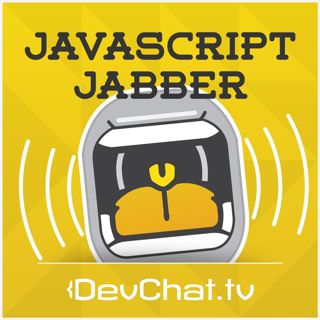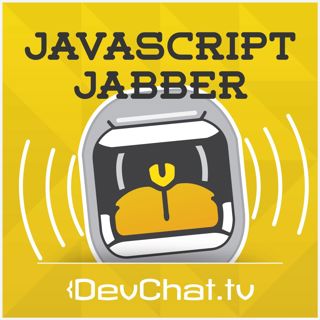
JSJ 333: “JavaScript 2018: Things You Need to Know, and a Few You Can Skip” with Ethan Brown
Panel: Aimee KnightJoe EamesCharles Max Wood Special Guests: Ethan Brown In this episode, the panel talks with Ethan Brown who is a technological director at a small company. They write software to facilitate large public organizations and help make projects more effective, such as: rehabilitation of large construction projects, among others. There is a lot of government work through the endeavors they encounter. Today, the panel talks about his article he wrote, and other topics such as Flex, Redux, Ruby, Vue.js, Automerge, block chain, and Elm. Enjoy!Show Topics:2:38 – Chuck: We are here to talk about the software side of things.Let’s dive into what you are looking at mid-year what we need to know for 2018. You wrote this.3:25 – Ethan: I start off saying that doing this podcast now, how quickly things change. One thing I didn’t think people needed to know was symbols, and now that’s changed. I had a hard time with bundling and other things. I didn’t think the troubles were worth it. And now a couple of moths ago (an open source project) someone submitted a PR and said: maybe we should be using symbols? I told them I’ve had problems in the past. They said: are you crazy?!It’s funny to see how I things have changed.4:47 – Panel: Could you talk about symbols?4:58 – Aimee: Are they comparable to Ruby?5:05 – Ethan talks about what symbols are and what they do!5:52 – Chuck: That’s pretty close to how that’s used in Ruby, too.6:04 – Aimee: I haven’t used them in JavaScript, yet. When have you used them recently?6:15 – Ethan answers the question.7:17 – Panelist chimes in.7:27 – Ethan continues his answer. The topic of “symbols” continues. Ethan talks about Automerge. 11:18 – Chuck: I want to dive-into what you SHOULD know in 2018 – does this come from your experience? Or how did you drive this list?11:40 – Ethan: I realize that this is a local business, and I try to hear what people are and are not using. I read blogs. I think I am staying on top of these topics being discussed.12:25 – Chuck: Most of these things are what people are talking.12:47 – Aimee: Web Assembly. Why is this on the list?12:58 – Ethan: I put on the list, because I heard lots of people talk about this. What I was hearing the echoes of the JavaScript haters. They have gone through a renaissance. Along with Node, and React (among others) people did get on board. There are a lot of people that are poisoned by that. I think the excitement has died down. If I were to tell a story today – I would14:23 – Would you put block chain on there? And AI?14:34 – Panel: I think it’s something you should be aware of in regards to web assembly. I think it will be aware of. I don’t know if there is anything functional that I could use it with.15:18 – Chuck: I haven’t really played with it...15:27 – Panel: If you wrote this today would you put machine learning on there?15:37 – Ethan: Machine Learning...16:44 – Chuck: Back to Web Assembly. I don’t think you were wrong, I think you were early. Web Assembly isn’t design just to be a ... It’s designed to be highly optimized for...17:45 – Ethan: Well-said. Most of the work I do today we are hardly taxing the devices we are using on.18:18 – Chuck and panel chime in.18:39 – Chuck: I did think the next two you have on here makes sense.18:54 – Panel: Functional programming?19:02 – Ethan: I have a lot of thoughts on functional programming and they are mixed. I was exposed to this in the late 90’s. It was around by 20-30 years. These aren’t new. I do credit JavaScript to bring these to the masses. It’s the first language I see the masses clinging to. 10 years ago you didn’t see that. I think that’s great for the programming community in general. I would liken it to a way that Ruby on Rails really changed the way we do web developing with strong tooling. It was never really my favorite language but I can appreciate what it did for web programming. With that said...(Ethan continues the conversation.)Ethan: I love Elm. 21:49 – Panelists talks about Elm. *The topic diverts slightly.22:23 – Panel: Here’s a counter-argument. Want to stir the pot a little bit. I want to take the side of someone who does NOT like functional programming.24:08 – Ethan: I don’t disagree with you. There are some things I agree with and things I do disagree with. Let’s talk about Data Structures. I feel like I use this everyday. Maybe it’s the common ones. The computer science background definitely helps out.If there was one data structure, it would be TREES. I think STACKS and QUEUES are important, too. Don’t use 200-300 hours, but here are the most important ones. For algorithms that maybe you should know and bust out by heart.27:48 – Advertisement for Chuck’s E-book Course: Get A Coder Job28:30 – Chuck: Functional programming – people talk bout why they hate it, and people go all the way down and they say: You have to do it this way....What pay things will pay off for me, and which things won’t pay off for me? For a lot of the easy wins it has already been discussed. I can’t remember all the principles behind it. You are looking at real tradeoffs. You have to approach it in another way. I like the IDEA that you should know in 2018, get to know X, Y, or Z, this year. You are helping the person guide them through the process.30:18 – Ethan: Having the right tools in your toolbox.30:45 – Panel: I agree with everything you said, I was on board, until you said: Get Merge Conflicts.I think as developers we are being dragged in...33:55 – Panelist: Is this the RIGHT tool to use in this situation?34:06 – Aimee: If you are ever feeling super imposed about something then make sure you give it a fair shot, first.34:28 – That’s the only reason why I keep watching DC movies.34:41 – Chuck: Functional programming and...I see people react because of the hype cycle. It doesn’t fit into my current paradigm. Is it super popular for a few months or...?35:10 – Aimee: I would love for someone to point out a way those pure functions that wouldn’t make their code more testable.35:42 – Ethan: Give things a fair shake. This is going back a few years when React was starting to gain popularity. I had young programmers all about React. I tried it and mixing it with JavaScript and...I thought it was gross. Everyone went on board and I had to make technically decisions. A Friend told me that you have to try it 3 times and give up 3 times for you to get it. That was exactly it – don’t know if that was prophecy or something. This was one of my bigger professional mistakes because team wanted to use it and I didn’t at first. At the time we went with Vue (old dog like me). I cost us 80,000 lines of code and how many man hours because I wasn’t keeping an open-mind?37:54 – Chuck: We can all say that with someone we’ve done.38:04 – Panel shares a personal story.38:32 – Panel: I sympathize because I had the same feeling as automated testing. That first time, that automated test saved me 3 hours. Oh My Gosh! What have I been missing!39:12 – Ethan: Why should you do automated testing? Here is why...You have to not be afraid of testing. Not afraid of breaking things and getting messy.39:51 – Panel: Immutability?40:00 – Ethan talks about this topic.42:58 – Chuck: You have summed up my experience with it.43:10 – Panel: Yep. I agree. This is stupid why would I make a copy of a huge structure, when...44:03 – Chuck: To Joe’s point – but it wasn’t just “this was a dumb way” – it was also trivial, too. I am doing all of these operations and look my memory doesn’t go through the roof. They you see it pay off. If you don’t see how it’s saving you effort, at first, then you really understand later.44:58 – Aimee: Going back to it being a functional concept and making things more testable and let it being clearly separate things makes working in code a better experience.As I am working in a system that is NOT a pleasure.45:31 – Chuck: It’s called legacy code...45:38 – What is the code year? What constitutes a legacy application?45:55 – Panel: 7 times – good rule.46:10 – Aimee: I am not trolling. Serious conversation I was having with them this year.46:27 – Just like cars.46:34 – Chuck chimes in with his rule of thumb.46:244 – Panel and Chuck go back-and-forth with this topic.47:14 – Dilbert cartoons – check it out. 47:55 – GREAT QUOTE about life lessons.48:09 – Chuck: I wish I knew then what I know now.Data binding. Flux and Redux. Lots of this came out of stuff around both data stores and shadow domes. How do you tease this out with the stuff that came out aroBecome a supporter of this podcast: https://www.spreaker.com/podcast/javascript-jabber--6102064/support.
2 Loka 201823min

JSJ 332: “You Learned JavaScript, Now What?” with Chris Heilmann
Panel: AJ O’NealAimee KnightJoe EamesCharles Max Wood Special Guests: Chris Heilmann In this episode, the panel talks with programmer, Chris Heilmann. He has written books about JavaScript, in addition to writing a blog about it and is an educator about this program. He currently resides in Berlin, Germany. Let’s welcome our special guest and listen to today’s episode!Show Topics:2:19 – Chuck talks.2:41 – Chris: He has talked about JavaScript in Berlin upon an invitation. You can get five different suggestions about how to use JavaScript. The best practices, I have found, are on the projects I am on now. JavaScript was built in ten days. My goal is to help people navigate through JavaScript and help them feel not disenfranchised. 5:47 – Aimee: The overall theme is...5:54 – Panelist: I really like what you said about helping people not feeling disenfranchised.6:47 – Chris: There is a lot of peer pressure at peer conferences7:30 – Aimee chimes in with some comments.7:50: Chris: I think we need to hunt the person down that put...8:03 – Panelist: A good point to that is, I try to avoid comments like, “Well, like we ALL know...”8:27 – Chris: There are things NOT to say on stage. It happens, but we don’t want to say certain things while we are teaching people. We are building products with different groups, so keep that in mind.9:40 – Aimee: My experience in doing this is that I have found it very rewarding to share embarrassing experiences that I’ve had. My advice would to tell people to let their guard down. It’s encouraging for me.10:26 – Chris: It helps to show that you are vulnerable and show that you are still learning, too. We are all learning together. 90% of our job is communicating with others.11:05 – Chuck: Now, I do want to ask this...11:35 – Chris answers.12:24 – What makes you say that? (Question to Chris)12:25 – Chris answers.13:55 – Chuck: The different systems out there are either widely distributed or...You will have to work with other people. There is no way that people can make that on their own. If you can’t work with other people, then you are a hindrance.14:31 – Aimee chimes in.14:53 – Chris: They have to be very self-assured. I want to do things that are at the next level. Each developer has his or her own story. I want to move up the chain, so I want to make sure these developers are self-assured.16:07 – Chris: Back to the article...18:26 – Chuck: Yes, I agree. Why go and fight creating a whole system when it exists.18:54 – Chris chimes in with some comments.19:38 – Panelist: I still use console logs.19:48 – Chris: We all do, but we have to...19:55 – Aimee: In the past year, I can’t tell you how much I rely on this. Do I use Angular? Do I learn Vue? All those things that you can focus on – tools.10:21 – Chris: We are talking about the ethics of interfaces. Good code is about accessibility, privacy and maintainability, among others. Everything else is sugar on top. We are building products for other people.22:10 – Chuck: That is the interesting message in your post, and that you are saying: having a deep, solid knowledge of React (that is sort of a status thing...). It is other things that really do matter. It’s the impact we are having. It’s those things that will make the difference. Those things people will want to work with and solves their problems.23:00 – Chris adds his comments. He talks about Flash.24:05 – Chris: The librarian motto: “I don’t know everything, but I can look “here” to find the answer.” We don’t know everything.24:31 – Aimee: Learn how to learn.24:50 – Chris: There is a big gap in the market. Scratch is a cool tool and it’s these puzzle pieces you put together. It was hard for me to use that system. No, I don’t want to do that. But if you teach the kids these tools then that’s good. 24:56 – Chuck: Here is the link, and all I had to do was write React components.26:12 – Chris: My first laptop was 5x more heavy then this one is. Having access to the Internet is a blessing.27:24 – Advertisement 28:21 – Chuck: Let’s bring this back around. If someone has gone through boot camp, you are recommending that they get use to know their editor, debugging, etc.Chris: 28:47 – Chris: Yes, get involved within your community. GitHub. This is a community effort. You can help. Writing code from scratch is not that necessary anymore. Why rebuild something if it works. Why fix it if it’s not broken?31:00 – Chuck talks about his experience.31:13 – Chris continues his thoughts.Chris: Start growing a community.32:01 – Chuck: What ways can people get involved within their community?32:13 – Chris: Meetup. There are a lot of opportunities out there. Just going online and seeing where the conferences34:08 – Chris: It’s interesting when I coach people on public speaking. Sharing your knowledge and learning experience is great!34:50 – Chuck: If they are learning how to code then...by interacting with people you can get closer to what you need/want.35:30 – Chris continues this conversation.35:49 – Chris: You can be the person that helps with x, y, z. Just by getting your name known then you can get a job offer.36:23 – Chuck: How do you find out what is really good content – what’s worth your time vs. what’s not worth your time?36:36 –Chris says, “That’s tricky!” Chris answers the question.37:19: Chris: The best things out there right now is...38:45 – Chuck: Anything else that people want to bring up?39:00 – Chris continues to talk.42:26 – Aimee adds in her thoughts.Aimee: I would encourage people to...43:00 – Chris continues the conversation.Chris: Each project is different, when I build a web app is different then when I build a...45:07 – Panelist: I agree. You talked about abstractions that don’t go away. You use abstractions in what you use. At some point, it’s safe to rly on this abstraction, but not this one. People may ask themselves: maybe CoffeeScript wasn’t the best thing for me.46:11 – Chris comments and refers to jQuery.48:58 – Chris continues the conversation.Chris: I used to work on eight different projects and they worked on different interfaces. I learned about these different environments. This is the project we are now using, and this will like it for the end of time. This is where abstractions are the weird thing. What was the use of the abstraction if it doesn’t have longevity? I think we are building things too soon and too fast.51:04 – Chris: When I work in browsers and come up with brand new stuff.52:21 – Panelist: Your points are great, but there are some additional things we need to talk about. Let’s take jQuery as an example. There is a strong argument that if you misuse the browser...53:45 – Chris: TheBecome a supporter of this podcast: https://www.spreaker.com/podcast/javascript-jabber--6102064/support.
25 Syys 20181h 14min

JSJ 331: “An Overview of JavaScript Testing in 2018” with Vitali Zaidman
Panel: - https://twitter.com/coolaj86?ref_src=twsrc%255Egoogle%257Ctwcamp%255Eserp%257Ctwgr%255Eauthor- http://www.aimeemarieknight.com- https://twitter.com/josepheames?ref_src=twsrc%255Egoogle%257Ctwcamp%255Eserp%257Ctwgr%255Eauthor- https://twitter.com/cmaxw?lang=en Special Guests: https://medium.com/@vzaidman In this episode, the panel talks with programmer, https://medium.com/@vzaidman, who is working with Software Solutions Company. He researches technologies and starts new projects all the time, and looks at these new technologies within the market. The panel talks about testing JavaScript in 2018 and https://jestjs.io.Show Topics:1:32 – Chuck: Let’s talk about testing JavaScript in 2018.1:53 – https://medium.com/@vzaidman talks about solving problems in JavaScript.2:46 – Chuck asks https://medium.com/@vzaidman a question.3:03 – Vitali’s answer.3:30 – Why https://jestjs.io? Why not Mocha or these other programs?3:49 – https://jestjs.io is the best interruption of what testing should look like and the best practice nowadays. There are different options, they can be better, but https://jestjs.io has this great support from their community. There are great new features.4:31 – Chuck to Joe: What are you using for testing nowadays?4:43 – Joe: I use Angular, primarily.6:01 – Like life, it’s sometimes easier to use things that make things very valuable.7:55 – Aimee: I have heard great things about http://www.cypress.com/documentation/software-and-drivers/free-and-open-source-software-download-page, but at work we are using another program.8:22 – Vitali: Check out my article.8:51 – Aimee: There are too many problems with the program that we use at work.9:39 – Panelist to Vitali: I read your article, and I am a fan. Why do you pick Test Café over Cypress, and how familiar are you with Cypress? What about Selenium and other programs?10:12 – Vitali: “Test Café and Cypress are competing head-to-head.”Listen to Vitali’s suggestions and comments per the panelists’ question at this timestamp.11:25 – Chuck: I see that you use sign-on...12:29 – Aimee: Can you talk abouthttps://github.com/GoogleChrome/puppeteer? It seems promising.12:45 – Vitali: Yes, Puppeteer is promising. It’s developed by Google and by Chrome. You don’t want to use all of your tests in Puppeteer, because it will be really hard to do in other browsers.13:26: Panelist: “...5, 6, 7, years ago it was important of any kind of https://www.javascript.com testing you had no idea if it worked in one browser and it not necessarily works in another browser. That was 10 years ago. Is multiple browsers testing as important then as it is now?14:51: Vitali answers the above question.15:30 – Aimee: If it is more https://www.javascript.com heavy then it could possibly cause more problems.15:56 – Panelist: I agree with this.16:02 – Vitali continues this conversation with additional comments.16:17 – Aimee: “I see that Safari is the new Internet Explorer.”16:23: Chuck: “Yes, you have to know your audience. Are they using older browsers? What is the compatibility?”17:01 – Vitali: There are issues with the security. Firefox has a feature of tracking protection; something like that.17:33 – Question to Vitali by Panelist.17:55 – Vitali answers the question.18:30 – Panelist makes additional comments.18:43 – If you use Safari, you reap what you sow.18:49 – Chuck: I use Chrome on my iPhone. (Aimee does, too.) Sometimes I wind up in Safari by accident.19:38 – Panelist makes comments.19:52 – Vitali tells a funny story that relates to this topic.20:45 – There are too many standards out there.21:05 – Aimee makes comments.21:08 – https://brutalist-web.design. Some guy has this site – https://brutalist-web.design – where he says use basic stuff and stop being so custom. Stop using the web as some crazy platform, and if your site is a website that can be scrolled through, that’s great. It needs to be just enough for people to see your content.22:16 – Aimee makes additional comments about this topic of https://brutalist-web.design.22:35 – Panelist: I like it when people go out and say things like that.22:45 – Here is the point, though. There is a difference between a website and a web application. Really the purpose is to read an article.23:37 – Vitali chimes in.24:01 – Back to the topic of content on websites.25:17 – Panelist: Medium is very minimal. Medium doesn’t feel like an application.26:10 – Is the website easy enough for the user to scroll through and get the content like they want to?26:19 – https://sentry.io/welcome/ 27:22 – See how far off the topic we got?27:31 – These are my favorite conversations to have.27:39 – Vitali: Let’s talk about how my article got so popular. It’s an interesting thing, I started researching “testing” for my company. We wanted to implement one of the testing tools. Instead of creating a presentation, I would write first about it in Medium to get feedback from the community as well. It was a great decision, because I got a lot of comments back. I enjoyed the experience, too. Just write about your problem in Medium to see what people say.28:48 – Panelist: You put a ton of time and energy in this article. There are tons of links. Did you really go through all of those articles?29:10 – Yes, what are the most permanent tools? I was just reading through a lot of comments and feedback from people. I tested the tools myself, too!29:37 – Panelist: You broke down the article, and it’s a 22-minute read.30:09 – Vitali: I wrote the article for my company, and they ad to read it.30:24 – Panelist: Spending so much time – you probably felt like it was apart of your job.30:39 – Vitali: I really like creating and writing. It was rally amazing for me and a great experience. I feel like I am talented in this area because I write well and fast. I wanted to express myself.31:17 – Did you edit and review?31:23 – Vitali: I wrote it by myself and some friends read it. There were serious mistakes, and that’s okay I am not afraid of mistakes. This way you get feedback.32:10 – Chuck: “Some people see testing in JavaScript, and people look at this and say there are so much here. Is there a place where people can start, so that way they don’t’ get too overwhelmed? Is there a way to ease into this and take a bite-size at a time?”32:52 – Vitali: “Find something that works for them. Read the article and start writing code.”He continues this conversation from here on out.34:03 – Chuck continues to ask questions and add other comments.34:16 – Vitali chimes-in. 34:38 – Chuck. 34:46 – Vitali piggybacks off of Chuck’s comments.36:14 – Panelist: Let’s go back to https://jestjs.io. There is a very common occurrence where we see lots of turn and we see ideas like this has become the dominant or the standard, a lot of people talk about stuff within this community. Then we get this idea that ‘this is the only thing that is happening.’ Transition to https://jquery.com to https://reactjs.org to... With that context do you feel like https://jestjs.io will be a dominant program? Are we going to see https://jestjs.io used just as common as Mocha and other popular programs?38:15 – Vitali comments on the panelist’s question.38:50 – Panelist: New features. Are the features in https://jestjs.io (over Jasmine, Mocha, etc.) so important that it will drive people to it by itself?40:30 – Vitali comments on this great question.40:58 – Panelist asks questions about features about https://jestjs.io.41:29 – Vitali talks about this topic.42:14 – Let’s go to picks!42:14 – https://www.digitalocean.com/ Links:- https://www.facebook.com/vzaidman- https://medium.com/@vzaidman- https://github.com/vzaidman- https://www.npmjs.com/~vzaidman-Become a supporter of this podcast: https://www.spreaker.com/podcast/javascript-jabber--6102064/support.
18 Syys 201855min

JSJ 330: “AWS: Amplify” with Nader Dabit
Panel: - AJ O’Neal- Aimee Knight- Joe Eames Special Guests: http://naderdabit.me/#/ In this episode, the panel talks with programmer, Nader Dabit, who has been with Amazon’s AWS for the past six months. They discuss the new innovations that Amazon is currently working on, and the exciting new projects that Nader gets to be involved with. Check out this episode to hear all the latest!Show Topics:1:45 – There are two main things that Nader works with. Check out this timestamp to see what they are.3:29 – AJ to Nader: Tell me more about manage cloud. I am not sure about https://aws.amazon.com/cognito/?ef_id=W5RTKgAAAUa7GPf1%3A20180908225434%3As&s_kwcid=AL%214422%213%21293649588890%21p%21%21g%21%21cognito&sc_campaign=acquisition_USsc_publisher%3Dgoogle&sc_category=Security&sc_channel=PS&sc_content=cognito_p&sc_country=US&sc_detail=cognito&sc_matchtype=p&sc_medium=ACQ-P%257CPS-GO%257CNon-Brand%257CDesktop%257CSU%257CSecurity%257CCognito%257CUS%257CEN%257CText&sc_segment=293649588890.3:56 – https://aws.amazon.com/cognito/?ef_id=W5RTKgAAAUa7GPf1%3A20180908225434%3As&s_kwcid=AL%214422%213%21293649588890%21p%21%21g%21%21cognito&sc_campaign=acquisition_USsc_publisher%3Dgoogle&sc_category=Security&sc_channel=PS&sc_content=cognito_p&sc_country=US&sc_detail=cognito&sc_matchtype=p&sc_medium=ACQ-P%257CPS-GO%257CNon-Brand%257CDesktop%257CSU%257CSecurity%257CCognito%257CUS%257CEN%257CText&sc_segment=293649588890 5:06 – What are the other manage cloud services that companies want to offer through the tools you have?5:12 – Nader answers AJ’s question.7:30 – Can you give me more specifics on the storage solutions you are offering?8:03 – Nader answers AJ’s question. People store websites there for example. Frontend developers are using S3 buckets, and they are using the library, which is a storage solution.9:10 – AJ and Nader are having a dialogue between different situations, and Nader is giving the solutions to those hypothetical situations.10:17 – AJ: “I am interested in what you are talking about https://aws.amazon.com/appsync/. Can you tell me how that works?” AJ is picking Nader’s brain about how https://aws.amazon.com/appsync/ works.11:05 – Nader: “It is a single API layer for a point of entry. You can have multi-data sources.” Nader continues, in detail, answering AJ’s question.12:36 – AJ: As a frontend developer, it sounds like I will have to become familiar with the backend, too. How is it providing the most value? What is it that I do not have to touch, because I am using this?15:37 – How would these relations work? As a frontend developer, and I do not want to learn sequel, how would that might look like; currently or in the future? How do you extract that knowledge?16:18 – Yes, it is not an easy solution to solve. Nader goes into detail about how he would approach this situation.18:26 – AJ: Are these resolvers written in https://www.javascript.com?22:04 – Acronym fun!22:45 – https://nodejs.org/en/ 23:51 – Summarizing these pasts 20-some-minutes: Off-Storage, https://aws.amazon.com/appsync/,https://sites.google.com/site/landismodel/developers, and others are what people are using Amplify for. New Question/New Topic: Simplify.25:45 – https://aws.amazon.com/mobile/ – is not mobile specific.26:44 – If you are using https://angular.io, we have a plugin in https://angular.io to help you. We also have that for React and https://vuejsdevelopers.com as well.27:52 – https://sentry.io/welcome/ 28:56 – What should we be talking about?29:04 – Let’s talk about Amazon’s Lex, https://aws.amazon.com/lex/?ef_id=W5RTKgAAAUa7GPf1%3A20180908230815%3As&s_kwcid=AL%214422%213%21209039218013%21p%21%21g%21%21amazon%2520chatbot&sc_campaign=lex_2017&sc_category=lex&sc_channel=PS&sc_content=chatbot_p&sc_country=US&sc_detail=amazon%2520chatbot&sc_matchtype=p&sc_medium=awns_lex_b&sc_publisher=google&sc_segment=209039218013. Nader goes into full detail of this service.33:52 – https://www.apple.com/tv/ 34:00 – AJ: Sounds like this is more platform/ more agnostic than getting different things to come together, and the Microsoft one is more hybrid and the Amazon one is more open?35:13 – Joe, let’s go back to what you had to ask.35:28 – Nader, you talked about https://www.biznessapps.com/blog/what-is-a-push-notification/ earlier. What is https://cloud.google.com/pubsub/docs/overview?36:30 – Is this like traditional hooks? Or custom?37:25 – What is the “stuff” that gets you up in the morning and gets you excited to go to work at AWS?38:40 – Nader: I really had no desire to change career paths, but it happened.41:30 – AJ: I totally agree with the idea in that finding the common patterns, so that way someone on the lower-level can participate. AJ wants a platform that is open or purchase that can offer some of these benefits. It could be open-source or you used to buy the different tools.43:27 AJ: What about for the hobbyist?43:40 – Nader: I agree, that would be really nice. I can’t think of any free services that would be nice.44:03 AJ – Not free in “free,” but “free” towards the idea of “free speech.” They would all be available and you get to choose what works well for you.45:00 – SHOUTOUT to LISTENERS: Have an idea about this? Shoot the panel an e-mail!45:33 – Hopefully this opens the listeners’ eyes to what’s out there.45:48 – Cloud services.46:55 – Innovation follows niche markets. When something gets big and established, innovation comes to a plateau. The innovation will develop in a new economic area like hydraulics. AJ thinks a niche will develop.49:03 – Is there anything, Dabit, which you would like to talk about?49:15 – Can we talk about https://docs.aws.amazon.com/aws-technical-content/latest/aws-overview/artificial-intelligence-services.html?51:10 – Nader saw a demonstration recently.52:26 – Hearing these implications is so cool, but when it comes to ML a panelist dabbled a little bit. He watched some videos, unless you want to devote a year or two to learning it then it’s too complex to put together. Do you have to be genius-level to get through?53:29 – ML you are passing data. Nader is not quite sure.56:00 Nader just did a blog post check-it-out!56:49 – Let’s do Picks!56:50 – https://www.digitalocean.com/ Links:- https://twitter.com/dabit3?ref_src=twsrc%255Egoogle%257Ctwcamp%255Eserp%257Ctwgr%255Eauthor- https://medium.com/@dabit3- https://www.linkedin.com/in/naderdabit/- https://github.com/dabit3- http://naderdabit.me/#/- https://www.youtube.com/channel/UC7mca3O0DmdSG2Cr80sOD7g- https://egghead.io/instructors/nader-dabit- https://www.javascript.com- https://aws.amazon.com/cognito/?ef_id=W5RTKgAAAUa7GPf1%3A20180908225434%3As&s_kwcid=AL%214422%213%21293649588890%21p%21%21g%21%21cognito&sc_campaign=acquisition_USsc_publisher%3Dgoogle&sc_category=Security&sc_channel=PS&sc_content=cognito_p&sc_country=US&sc_detail=cognito&sc_matchtype=p&sc_medium=ACQ-P%257CPS-GO%257CNon-Brand%257CDesktop%257CSU%257CSecurity%257CCognito%257CUS%257CEN%257CText&sc_segment=293649588890- https://aws.amazon.com/appsync/https://nodejs.org/en/- https://sites.google.com/site/landismodel/developers- https://aws.amazon.com/mobile/- https://vuejsdevelopers.com- https://angular.io-Become a supporter of this podcast: https://www.spreaker.com/podcast/javascript-jabber--6102064/support.
11 Syys 20181h 4min

JSJ 329: Promises, Promise.finally(), and Async/await with Valeri Karpov
Panel: Charles Max WoodAJ O’NealAimee Knight Special Guests: Valeri Karpov In this episode, the panel talks with programmer, Valerie Karpov from Miami, Florida. He is quite knowledgeable with many different programs, but today’s episode they talk specifically about Async/Await and Promise Generators. Val is constantly busy through his different endeavors and recently finished his e-book, “Mastering Async/Await.” Check-out Val’s social media profiles through LinkedIn, GitHub, Twitter, and more.Show Topics:1:20 – Val has been on previous episodes back in 2013 & 2016.1:37 – Val’s background. He is very involved with multiple companies. Go checkout his new book! 2:39 – Promises generators. Understand Promises and how things sync with Promises. Val suggests that listeners have an integrated understanding of issues like error handling.3:57 – Chuck asks a question.6:25 – Aimee’s asks a question: “Can you speak to why someone would want to use Async/Await?”8:53 – AJ makes comments.10:09 – “What makes an Async/Await not functional?” – Val10:59 – “What’s wrong with Promises or Async/Await that people don’t like it?” - AJ11:25 – Val states that he doesn’t think there really is anything wrong with these programs it just depends on what you need it for. He thinks that having both gives the user great power.12:21 – AJ’s background is with Node and the Python among other programs.12:55 – Implementing Complex Business Logic.15:50 – Val discusses his new e-book.17:08 – Question from Aimee.17:16 – AJ answers question. Promises should have been primitive when it was designed or somewhat event handling.17:46 – The panel agrees that anything is better than Call Backs.18:18 – Aimee makes comments about Async/Await.20:08 – “What are the core principles of your new e-book?” – Chuck20:17 – There are 4 chapters and Val discusses, in detail, what’s in each chapter.22:40 – There could be some confusion from JavaScript for someone where this is their first language. Does Async/Await have any affect on the way you program or does anything make it less or more confusing in the background changes?24:30 – Val answers the before-mentioned question. Async/Await does not have anyway to help with this (data changes in the background).25:36 – “My procedural code, I know that things won’t change on me because it is procedural code. Is it hard to adjust to that?” – AJ26:01 – Val answers the question.26:32 – Building a webserver with Python. 27:31 – Aimee asks a question: “Do you think that there are cases in code base, where I would want to use Promises? Not from a user’s perspective, but what our preferences are, but actual performance. Is there a reason why I would want to use both or be consistent across the board?”28:17 – Val asks for some clarification to Aimee’s question.29:14 – Aimee: “My own personal preference is consistency. Would I want to use Promises in ‘x’ scenario and/or use Async/Await in another situation?”32:28 – Val and AJ are discussing and problem solving different situations that these programs33:05 – “When would you not want to use Async/Await?” – AJ33:25 – Val goes through the different situations when he would not use Async/Await. 33:44 – Chuck is curious about other features of Async/Await and asks Val.36:40 – Facebook’s Regenerator 37:11 – AJ: “Back in the day, people would be really concerned with JavaScript’s performance even with Chrome.” He continues his thoughts on this topic.38:11 – Val answers the AJ’s question.39:10 – Duck JS probably won’t include generators.41:18 – Val: “Have anyone used Engine Script before?” The rest of the panel had never heard of this before.42:09 – Windows Scripting Host 42:56 – Val used Rhino in the past.43:40 – Val: “Going back to the web performance question...”47:08 – “Where do you see using Async/Await the most?” – Chuck47:55 – Val uses Async/Await for everything on the backend because it has made everything so easy for him.48:23 – “So this is why you really haven’t used Web Pack?” – AJ49:20 – Let’s go to Aimee’s Picks!50:18 – AJ’s story, first, before we get to Promises.54:44 – Let’s transition to Promises Finally.54:53 – Val talks about Promises Finally.59:20 – PicksLinks:JavaScriptValeri Karpov’s GitHubValeri Karpov’s TwitterValeri Karpov’s LinkedInNew E-Book: Mastering Async/AwaitNodePythonWindows Scripting HostFacebook’s RegeneratorRhinoSponsors:Kendo UISentryDigital Ocean Picks:CharlesYouTube Video “IKEA” by CoultonConferenceAmazon Prime DayAimeeBlog Post ArticleAJIKEAhttps://ppl.familyValhttps://www.npmjs.com/package/servehttp://bit.ly/ultimate-skiinghttp://asyncawait.net/jsjabberNew E-Book: Mastering Async/AwaitSupport this podcast at — https://redcircle.com/javascript-jabber/donationsPrivacy & Opt-Out: https://redcircle.com/privacyBecome a supporter of this podcast: https://www.spreaker.com/podcast/javascript-jabber--6102064/support.
4 Syys 201846min

JSJ 328: Functional Programming with Ramda with Christine Legge
Panel: Joe EamesAimee KnightAJ O'NealJoe Eames Special Guests: Christine LeggeIn this episode, the JavaScript Jabber panel talks to Christine Legge about functional programming with Ramda. Christine is a front-end software engineer and just recently got a new job in New York working at Google. Ramda is a utility library in JavaScript that focuses on making it easier to write JavaScript code in a functional way. They talk about functional programming and what it is, using Ramda in Redux, and referential transparency. They also touch on why she first got into Ramda, compare Ramda to Lodash and Underscore, and more!In particular, we dive pretty deep on:Chirstine intro Works as a front-end software engineerWhat is Ramda? JavaScriptUtility library like Lodash and UnderscoreLodash and Underscore VS RamdaFunctional programmingRamda and Functional programming as a mindsetRamda at ZenHubRamda with Redux and ReactWhat is referential transparency?Why would you use Ramda VS Lodash or Underscore?Why she first got into RamdaDidn’t always want to be a programmerBackground in MathLearning functional programming as a new programmerErlangDrRacket and JavaRamda makes it easy to compose functionsCreating clean and reusable codeHow do you start using Ramda?And much, much more! Links:RamdaLodashUnderscoreZenHubReduxReactErlangDrRacket@leggechrChirstine’s GitHubSponsorsKendo UISentryDigital OceanPicks:CharlesHome Depot Tool RentalPodcast MovementCESVRBOAimeeApple Cider VinegarJeremy Fairbank Talk – Practical Functional ProgrammingAJGoat’s MilkJoeTopgolfFramework SummitChristineDan ManganReply All PodcastSupport this podcast at — https://redcircle.com/javascript-jabber/donationsPrivacy & Opt-Out: https://redcircle.com/privacyBecome a supporter of this podcast: https://www.spreaker.com/podcast/javascript-jabber--6102064/support.
28 Elo 201855min

JSJ 327: "Greenlock and LetsEncrypt" with AJ O'Neal
Panel:Charles Max WoodJoe Eames Special Guests: AJ O'NealIn this episode, the JavaScript Jabber panel talks to AJ O'Neal about Greenlock and LetsEncrypt. LetsEncrypt is a brand name and is the first of its kind in automated SSL and Greenlock does what Certbot does in a more simplified form. They talk about what led him to create Greenlock, compare Greenlock to Certbot, and what it’s like to use Greenlock. They also touch on Greenlock-express, how they make Greenlock better, and more!In particular, we dive pretty deep on:Greenlock and LetsEncrypt overviewLetsEncrypt is free to get your certificateWhy Charles uses LetsEncryptWildcard domainsCertbotWhy he originally created GreenlockWorking towards home serversWanted to get HTTP on small devicesManages a certificate directoryGreenlock VS CertbotGreenlock can work stand aloneThe best use case for GreenlockExcited about how people are using his toolWhat is it like to use Greenlock?Working on a desktop clientGreenlock-expressAcme serversCAA recordMaking Greenlock better by knowing how people are using itUsing Greenlock-expressLet's Encrypt v2 Step by Step by AJAnd much, much more!Links:LetsEncryptGreenlockCertbotGreenlock-expressAcme serversLet's Encrypt v2 Step by Step by AJ@coolaj86coolaj86.comAJ’s GitGreenlock.js Screencast SeriesGreenlock.js PatreonSponsorsKendo UISentryDigital OceanPicks:CharlesTake some time offAJOverClocked RecordsSupport this podcast at — https://redcircle.com/javascript-jabber/donationsPrivacy & Opt-Out: https://redcircle.com/privacyBecome a supporter of this podcast: https://www.spreaker.com/podcast/javascript-jabber--6102064/support.
21 Elo 201855min

JSJ 326: Conversation with Ember co-creator Tom Dale on Ember 3.0 and the future of Ember
Panel: Joe EamesAimee KnightAJ ONeal Special Guests: Tom DaleIn this episode, the JavaScript Jabber panel talks to Tom Dale about Ember 3.0 and the future of Ember. Tom is the co-creator of Ember and is a principle staff engineer at LinkedIn where he works on a team called Presentation Infrastructure. They talk about being in the customer service role, having a collaborative culture, and all the information on Ember 3.0. They also touch on the tendency towards disposable software, the Ember model, and more!In particular, we dive pretty deep on:How Joe met TomProgrammers as rule breakersThe pressure to conformTom introStaff engineer at LinkedInCustomer service roleHaving a way to role improvements out to a lot of different peopleJavaScript and Ember at LinkedInHaving a collaborative cultureAll about Ember 3.0Banner feature – there is nothing newCracked how you develop software in the open source world that has longevityMajor competition in Backbone previouslyThe Ember community has never been more vibrantTendency towards disposable softwareThe idea of steady iteration towards improvementThe Ember modelBeing different from different frameworksEmber adoption ratesPython 3Valuable from a business perspective to use EmberEmber community being friendly to newbiesHow much Ember VS how much JavaScript will a new developer have to learn?And much, much more!Links:EmberLinkedInJavaScriptBackbonePython@tomdaletomdale.netTom’s GitHubSponsorsKendo UISentryDigital OceanPicks:JoeFramework SummitJayneReact sent Evan You a cakeAimeeMaker's Schedule, Manager's Schedule by Paul GrahamAJJames VeitchTomJavaScript Tech TalkDrake’s TiesMelissa Watson Ellis at Hall MaddenSupport this podcast at — https://redcircle.com/javascript-jabber/donationsPrivacy & Opt-Out: https://redcircle.com/privacyBecome a supporter of this podcast: https://www.spreaker.com/podcast/javascript-jabber--6102064/support.
14 Elo 201857min






















